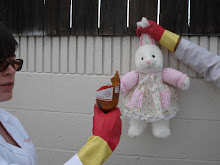 One incarnation of calcium carbonate is chalk. You ever heard of the white cliffs of Dover? The cliffs in southern England that face Continental Europe? They’re famous for being the first thing that lots of folks see when they cross the English Channel. I guess that’s a big deal when it comes to wars and stuff, but what do I know, I’m no historian!
One incarnation of calcium carbonate is chalk. You ever heard of the white cliffs of Dover? The cliffs in southern England that face Continental Europe? They’re famous for being the first thing that lots of folks see when they cross the English Channel. I guess that’s a big deal when it comes to wars and stuff, but what do I know, I’m no historian! The white that you see in this formation is mostly coccolith fossils. Tons and tons and TONS of coccolith fossils make up this geologic structure. There are some remains of sponges and corals thrown in for good measure.
The white that you see in this formation is mostly coccolith fossils. Tons and tons and TONS of coccolith fossils make up this geologic structure. There are some remains of sponges and corals thrown in for good measure.Anyways, we talked a long time ago about these other phytoplankton called Diatoms (see “Die, Die Diatoms my darling”). Diatoms protect themselves with silica whereas Coccolithophores protect themselves with calcium carbonate. The thing to know about phytoplankton is that they are all competing for nutrients in the surface ocean. Plants need nutrients like nitrate and phosphate to be happy campers, just look at the main ingredients in fertilizer the next time you’re at Home Depot.
The good news is that diatoms and coccolithophores thrive under very different oceanic conditions. Say there’s a huge rainstorm in Southern California. All the river runoff, sewage spills, and general poopieness supply nutrients (and diapers!) to the coastal surface water. Like we talked about before, diatoms are really good at swooping in and taking advantage of all nutrients. Given proper nutrients, a diatom population can grow crazy fast, resulting in what we call a “diatom bloom”. Coccolithophores, however, grow well in lower nutrient areas. They can be found way out in the middle of nowhere, thriving in waters with super-low nutrient levels. Good for them because this means they can out-compete a whimpier phytoplankton and take control of vast areas of ocean.
So now you’ve gotten a peak at the ancient competition for ocean nutrients between Diatoms and Coccolithophores. Two phytoplankton enter, one phytoplankton leaves!


2 comments:
I'm glad I got past the giggling as phonetically Coccolithophores (yes I had to check the spelling 3x) is not only fun to say, but it also sounds dirty. Did I say I got past the giggling? Oh yeah, and I done learneded something again. Thanks PK.
A microscopic grudge match for the ages!!!
Post a Comment